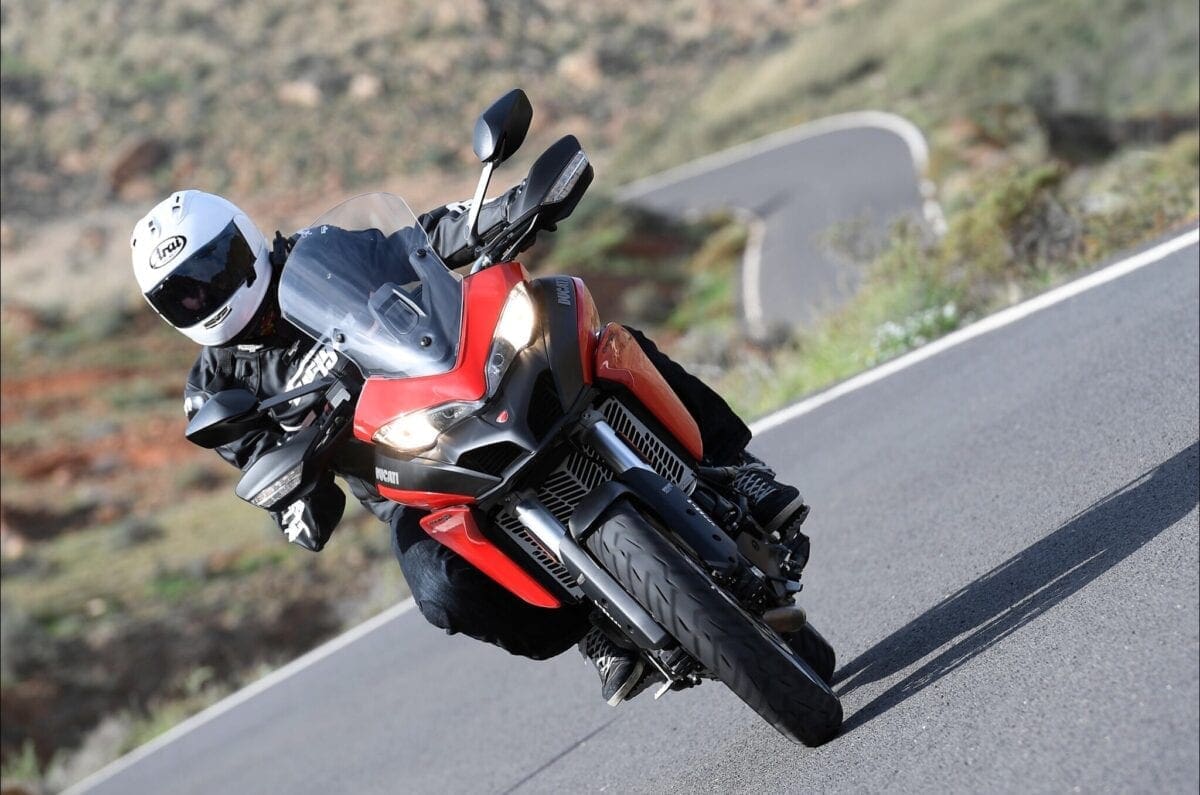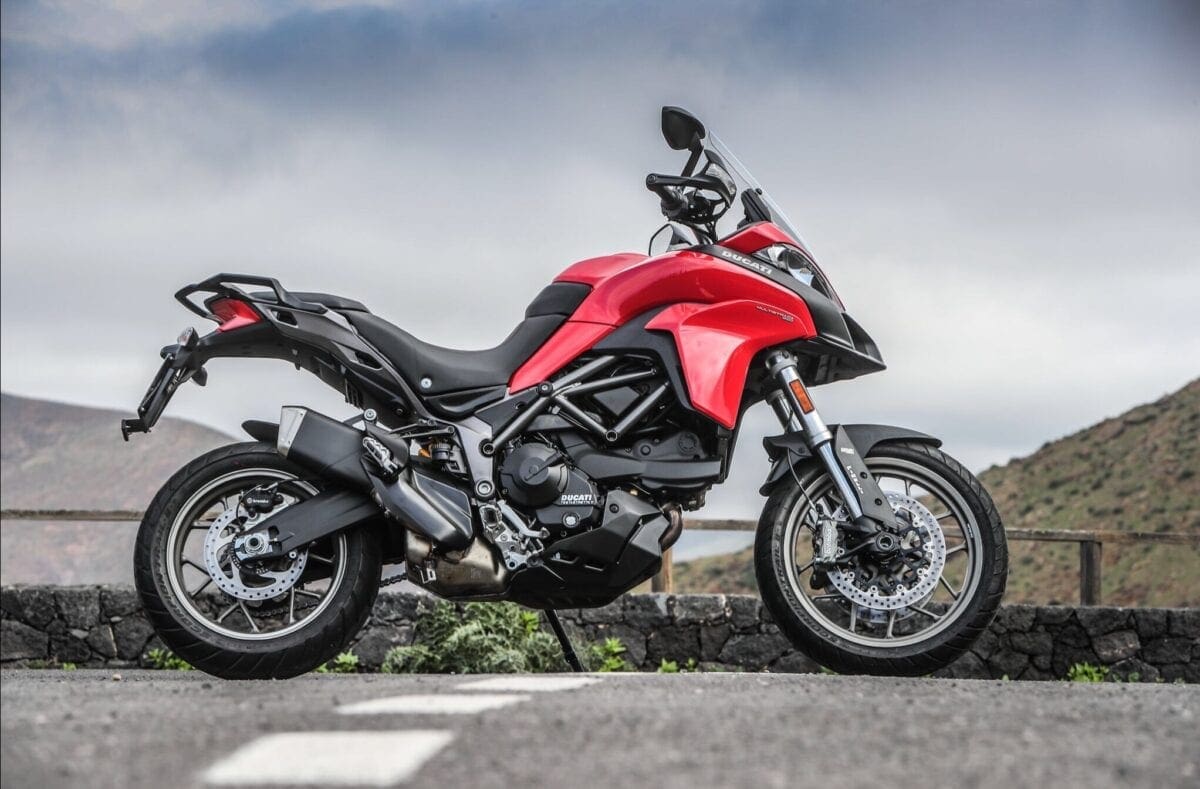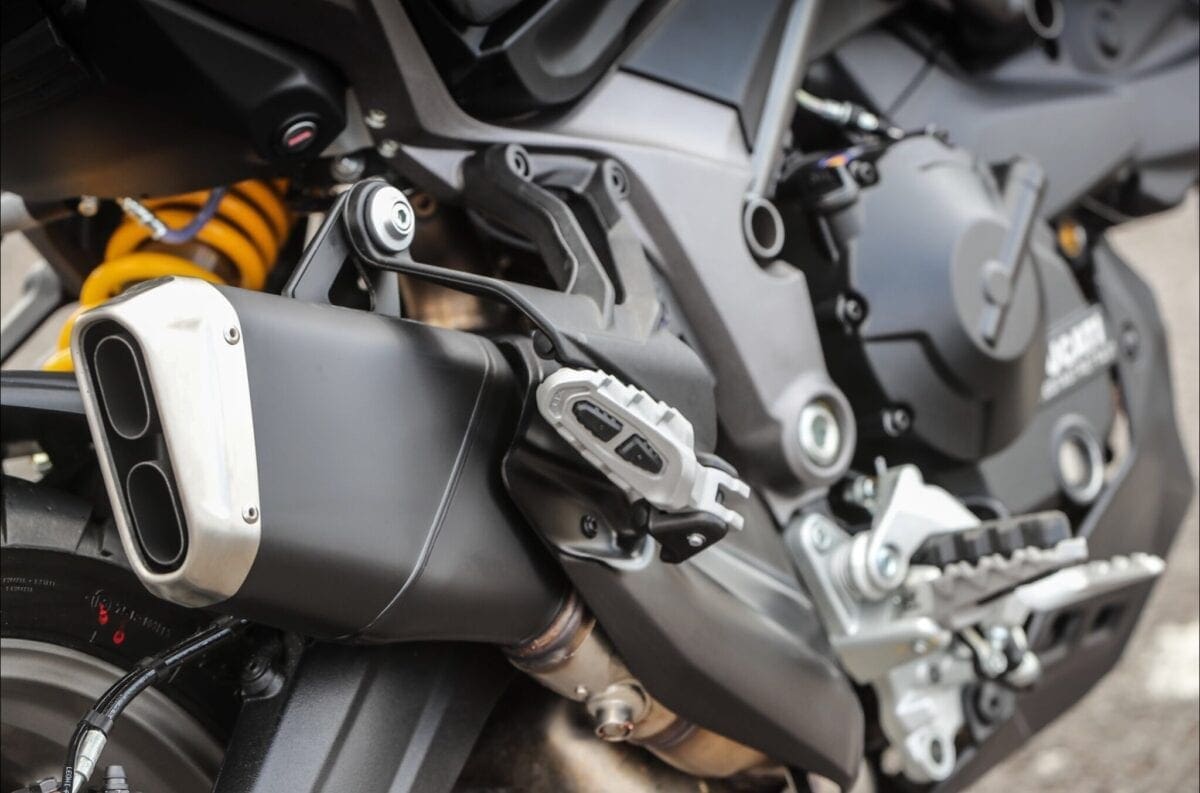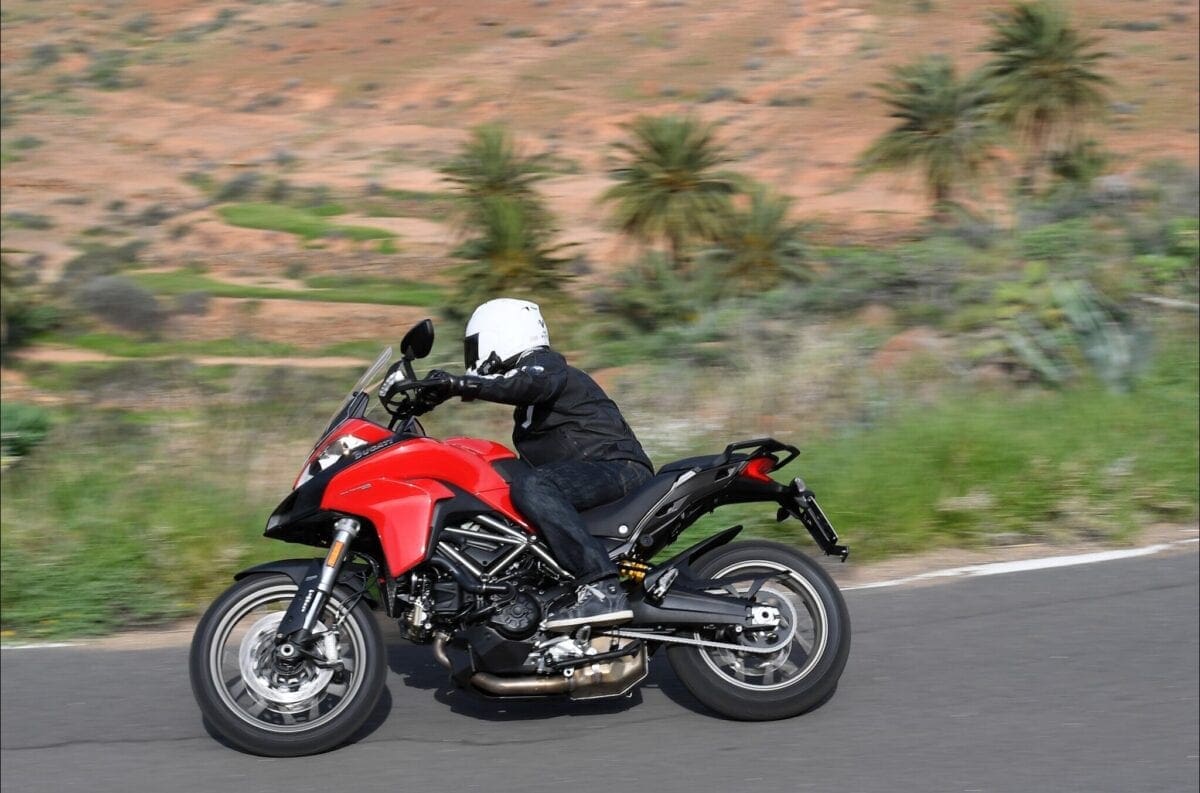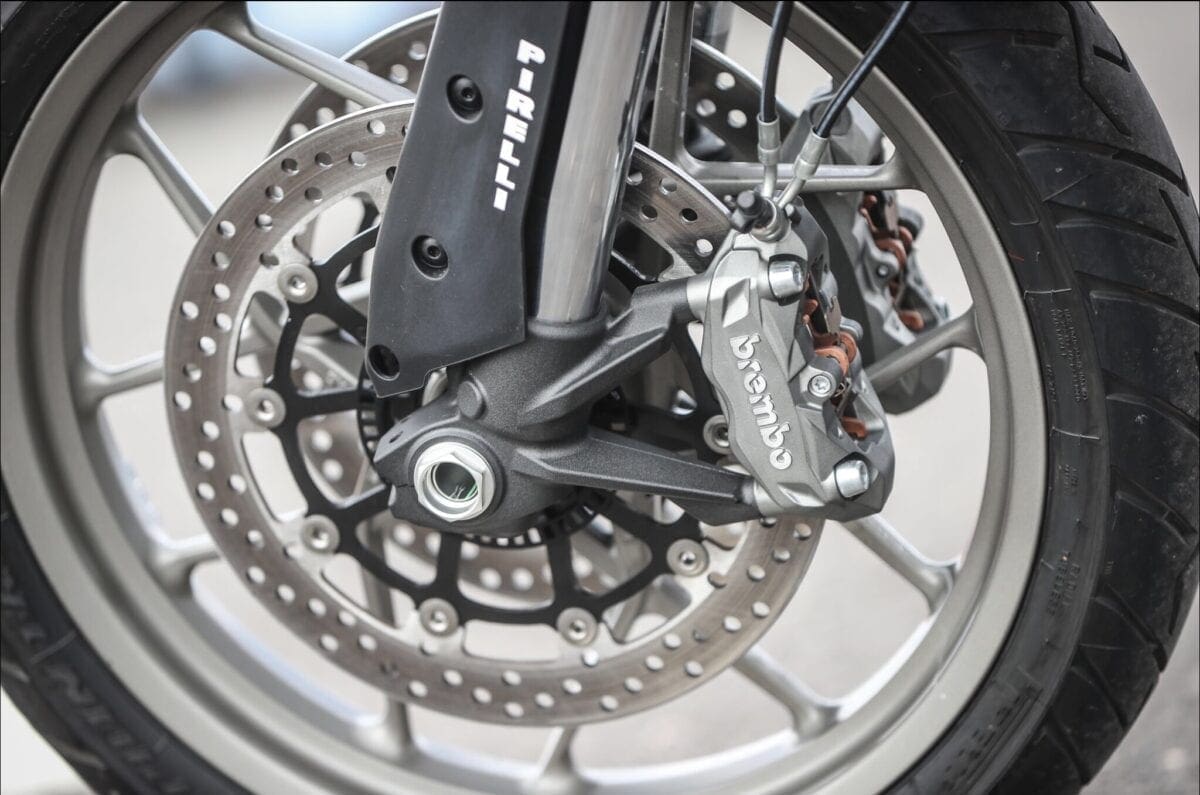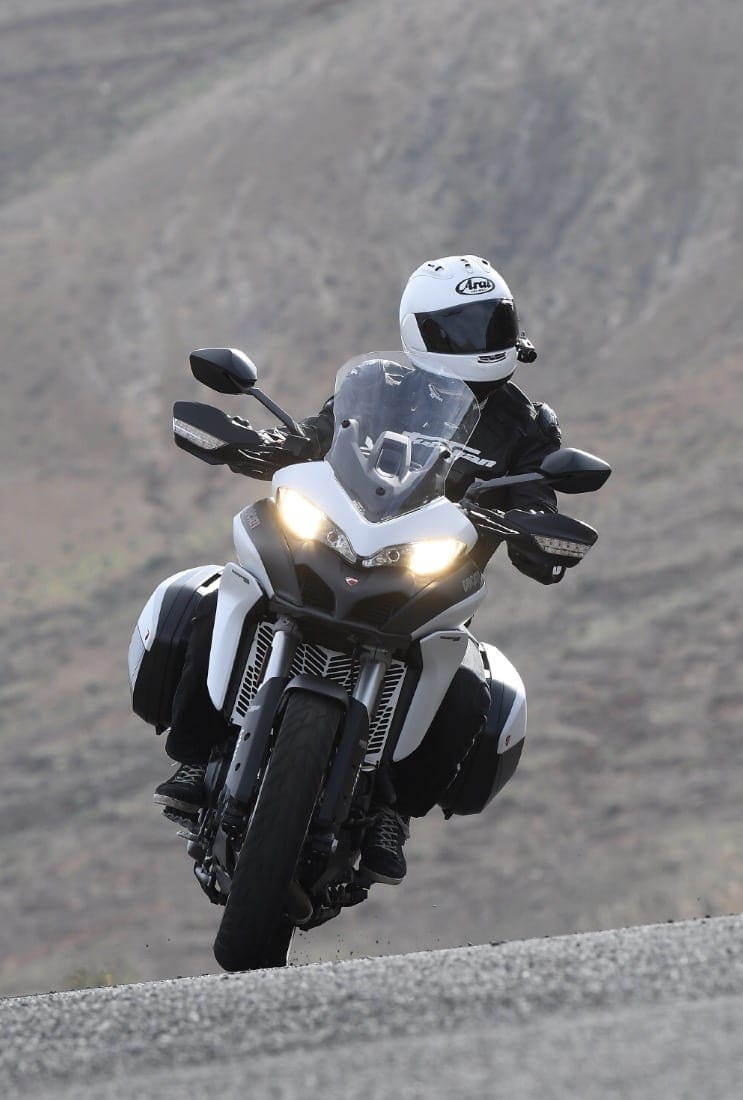Launch ride: Ducati Multistrada 950.
Words: Mikko Nieminen
Photos: Ducati
The Ducati Multistrada 950 is the new, more accessible addition to the Multistrada family. Ducati says it’s four bikes in one: a bike you can use for touring, urban, sporty or enduro riding. And as Ducatis go, this one is quite affordable too.
The smaller Multistrada shares a lot of its components with the full-fat version, including the frame and much of the chassis, but the smaller capacity engine – although still powerful – should make this more of an easy-going everyday bike than its high-maintenance big sister. The engine, riding modes, geometry and rider comfort have all been designed to make this an easy-to-live-with bike, and appealing for people who don’t necessarily feel like they need all that power, instead preferring to trade some of the horses for extra stability, everyday usability and smoother power delivery.
For Ducati, the Multistrada 950 is something of a low-cost bike, but it still looks and feels premium. The styling is derived from the Multistrada 1200, with touches of the Multistrada 1200 Enduro such as the 19-inch front wheel, double-sided swingarm and pillion grab rail, as well as some items, like the new seat unit, that are unique to the 950. The overall appearance is great and at a glance you might be hard pressed to say whether you were looking at a 950 or 1200 version.
The LCD dash is easy to read and although the electronics package from the 1200 has been simplified for this bike there are still more options in the menu than there are types of pasta in Bologna. In addition to seeing your speed, revs, fuel consumption, range, journey time, odometer, trips, clock and temperature (both engine and outside), you can also control the ride modes, traction control, ABS and even the brake lights here by using the switchgear on the left handlebar.
Changing the settings is fairly easy once you suss out the controls, although it’s very easy to switch the full beam on when toggling through the settings.
At 227kg the new bike is only 5 kilos lighter than its big sister, which makes the smaller engine work harder, but there’s plenty of power for everything apart from the sportiest rides. With Ducati’s 4-in-1 philosophy this bike was always going to be something of a compromise, so it won’t be competing against the top bikes built for a single purpose (Ducati has other offerings for that).
Versatile engine
Ducati engineers say that they designed the Multistrada 950 around the 937cc Testastretta L-twin liquid-cooled engine rather than trying to find an engine to match the existing Multistrada 1200 chassis. The same motor also powers the Hypermotard 939 and the new SuperSport, but this incarnation has dedicated intake and exhaust systems as well as a new engine management system. The changes have resulted in a wider power band across the rev range that helps make this bike feel less aggressive and easier to handle.
The maximum power output of 113bhp at 9,000rpm may be well short of the 160bhp of the bigger Multistrada, but if you compare it to the direct competitors (BMW F 800 GS: 85bhp, Honda Africa Twin: 94bhp) it starts to look much better. The bike doesn’t feel under-powered, and I quite enjoyed the feeling of being able to fully open the throttle for hard acceleration without the bike trying to instantly kill you.
The torque figures are good too (71lb-ft at 7,750rpm), and Ducati claims that 80% of maximum torque is available between 3,500rpm and 9,500rpm, which should help make this bike lively enough for experienced riders, but not too threatening to new or inexperienced bikers. Sure enough, there were good levels of power and torque across the rev range, but even with the wider power band and the plentiful torque, the bike seemed to only really come alive after 6,000rpm on our test ride.
Spoilt for choice
At the press conference before the test ride Ducati engineers and marketeers clearly wanted to emphasise two main characteristics of the bike: its versatility and accessibility.
The versatility comes in the form of four riding modes: Sport, Touring, Urban and Enduro. The ride modes control the throttle response, the amount of power available and the level of traction control and ABS. We tested the bike on the dry, smooth and grippy roads of Fuerteventura, where the Sport mode proved to be the best option by some margin. Both the Sport and Touring modes offer full power, but the throttle response is more instant in the Sport mode and there’s slightly less interference from traction control and ABS. I particularly enjoyed the mid-level traction control selected as default for the Sport mode, which allowed for the front wheel to lift off the ground under hard acceleration just enough to add a bit of a fun factor to the ride but also to control it enough to provide a reassuring safety net in case I got too carried away. The touring mode wasn’t far off the Sport mode, but the throttle response wasn’t quite as sharp. Both the Urban and Enduro modes cut the power to 75bhp and in the case of the Urban add more traction control and ABS, while the Enduro mode reduces traction control and ABS. We only tested the bike on tarmac roads so the Enduro mode didn’t really get properly tested. For our riding conditions the Urban mode seemed a bit pointless too because the ride-by-wire throttle controls the fuel injection so smoothly that even with the more aggressive riding modes it was easy enough to roll on and off the gas without any snatching. However, I can imagine that had I ridden the same bike back in the UK on the wet, greasy and bumpy winter roads, I might have given more consideration to the Urban mode. Each of the ride modes can also be customised with traction control (eight levels) and ABS (three levels) settings and the selection saved.
Riding in my comfort zone
To make the Multistrada 950 as accessible as possible, Ducati engineers had to make some adjustments to the geometry inherited from its 1200cc sibling. These include increasing the wheelbase to 1,594mm (63mm longer than the standard Multistrada 1200), using a 19-inch front wheel and the double-sided swingarm from the Multistrada 1200 Enduro, as well as rebuilding the forks. The aim of all these changes was to add stability to the new bike and to make it easier to ride.
The riding position is also slightly revised as the new bike features a dedicated new seat with a moderate height of 840mm. The bars are wide and confidence-inspiring, while the foot pegs with their big rubber pads reduce vibration and allow for a relaxed knee angle. The riding position is perfectly natural and upright, and the seat is firm but utterly comfortable. There’s also an adjustable screen, which deflects wind off the rider effectively, although at my height (6ft) it doesn’t seem to make much difference whether the screen is in the up or down position.
In towns, the Multistrada 950 is an easy bike to ride. The clutch is light, the steering angle generous, and because the seat isn’t that high I can get both of my feet flat on the ground. Despite its 227kg kerb weight (with 90% of fuel onboard), the overwhelming feeling is that of lightness and agility that suggest this could be a great commuter bike.
As the speed and revs rose on the open road, the bike remained comfortable, but when pushed hard the front sometimes felt a little vague in cornering. From around 6,000rpm I also started to feel the bike vibrating slightly. At first I noticed the mirrors starting to blur my view rearwards, and then with the revs climbing up I could feel the vibes, not through the bars or the pegs, but through the seat. It’s not so much an uncomfortable feeling as a bit odd, and it certainly doesn’t take away from the fun of riding.
After lunch we swapped the standard bikes to ones with panniers and centre stands bolted on, and on this bike I didn’t feel those vibes through the seat at all, making me wonder whether I had imagined the whole thing, but since Ducatis are hand-built, I suppose it’s entirely possible for them to have individual characteristics like this. Either that or the added equipment made the difference.
One thing that was certain after lunch was that with the added weight of the luggage and centre stand, the bike needed the suspension firmed up. The rear preload of the Sachs shock absorber had been increased by five clicks to accommodate this, but it still left the front feeling very soft, so I added preload, compression and rebound damping to the Kayaba 48mm upside-down forks at the first opportunity. That seemed to work and the bike felt much more planted and composed. Harder settings also seemed to make the front feel less vague, so maybe the standard settings have been designed for lighter riders – those less keen on cake than myself.
The front brakes are Brembo M4.32 monoblock radial calipers with four 32mm pistons and 320mm discs. And they work like a dream. The brake lever is adjustable so you can get the setup just right and then just dab a couple of fingers on the lever to feel the brakes biting. The single 265mm disc and the floating Brembo caliper at the rear didn’t feel as effective, but that was mostly because I couldn’t quite get on with the brake pedal position. For me it felt too far down and close to the bike for my foot to find it instantly.
The ABS system works fine as long as you are on Tarmac. I tested the rear brake on a dirt road with the ABS on and it felt like there were no brakes at all, so for any enduro riding, no matter how light, I would switch the ABS off completely.
Is it worth the money?
The standard-spec Multistrada has a price tag of £10,995 (that’s for the red one – if you want it in white it’ll cost an extra £200, and no, we don’t get why that is either!), which means it’s more than two grand cheaper than the 1200 version. More importantly, and unlikely by coincidence, it’s very close to its competitors’ pricing, with the Honda Africa Twin marginally cheaper at £10,849. Given the long service intervals (9,000 miles / 18,000 miles for valve clearance check), reasonable fuel consumption (we achieved 46mpg, but that was with the Sport mode and rather spirited riding), and the eventual PCP deals when the bike hits the showrooms in late January (there’s talk of a 25% deposit followed by £119/month over 36 months), this should be an affordable bike to run, for a Ducati at least.
Specification
Price: £10,995 (red), £11,195 (white)
Engine: 937cc, Testastretta, liquid-cooled L-twin, 4-valvesper cylinder
Power: 113bhp @ 9,000rpm
Torque: 71lb-ft @ 7,750rpm
Transmission: 6-speed, chain final drive
Frame: Tubular steel trellis frame
Brakes: (F) Brembo M4.32 monoblock radial calipers with four 32mm pistons and 320mm semi-floating discs. (R) Two-piston floating Brembo caliper, single 265mm disc.
Suspension: Fully adjustable (F) 48mm Kayaba upside-down forks (R) Sachs single shock
Tyres: Pirelli Scorpion Trail II (F) 120/70 R19 (R) 170/60 R17
Wheelbase: 1,594mm
Seat height: 840mm
Fuel capacity: 20 litres
Kerb weight: 227kg
Contact: www.ducatiuk.com

